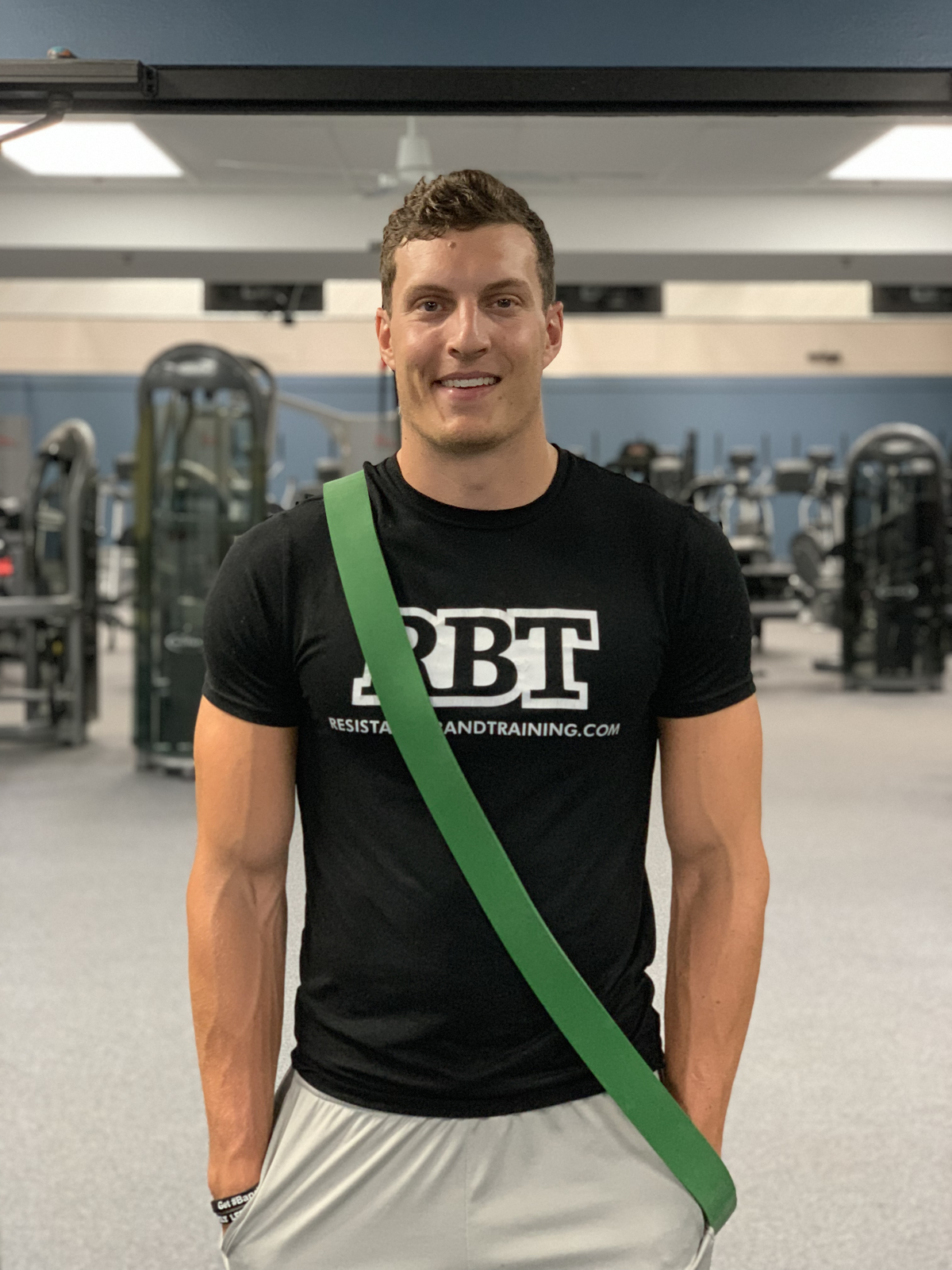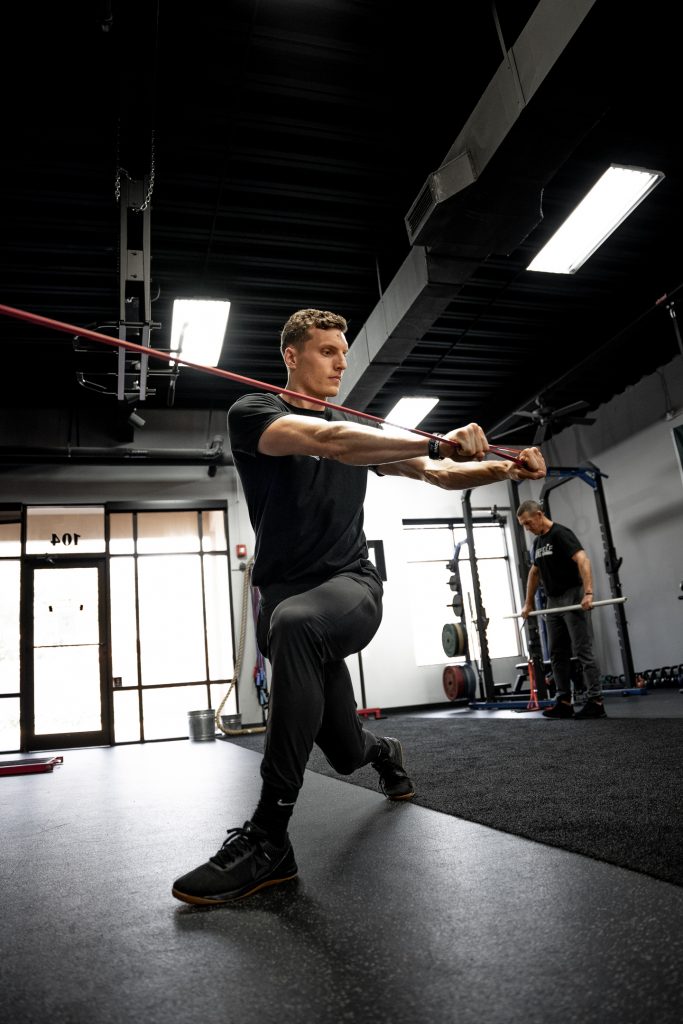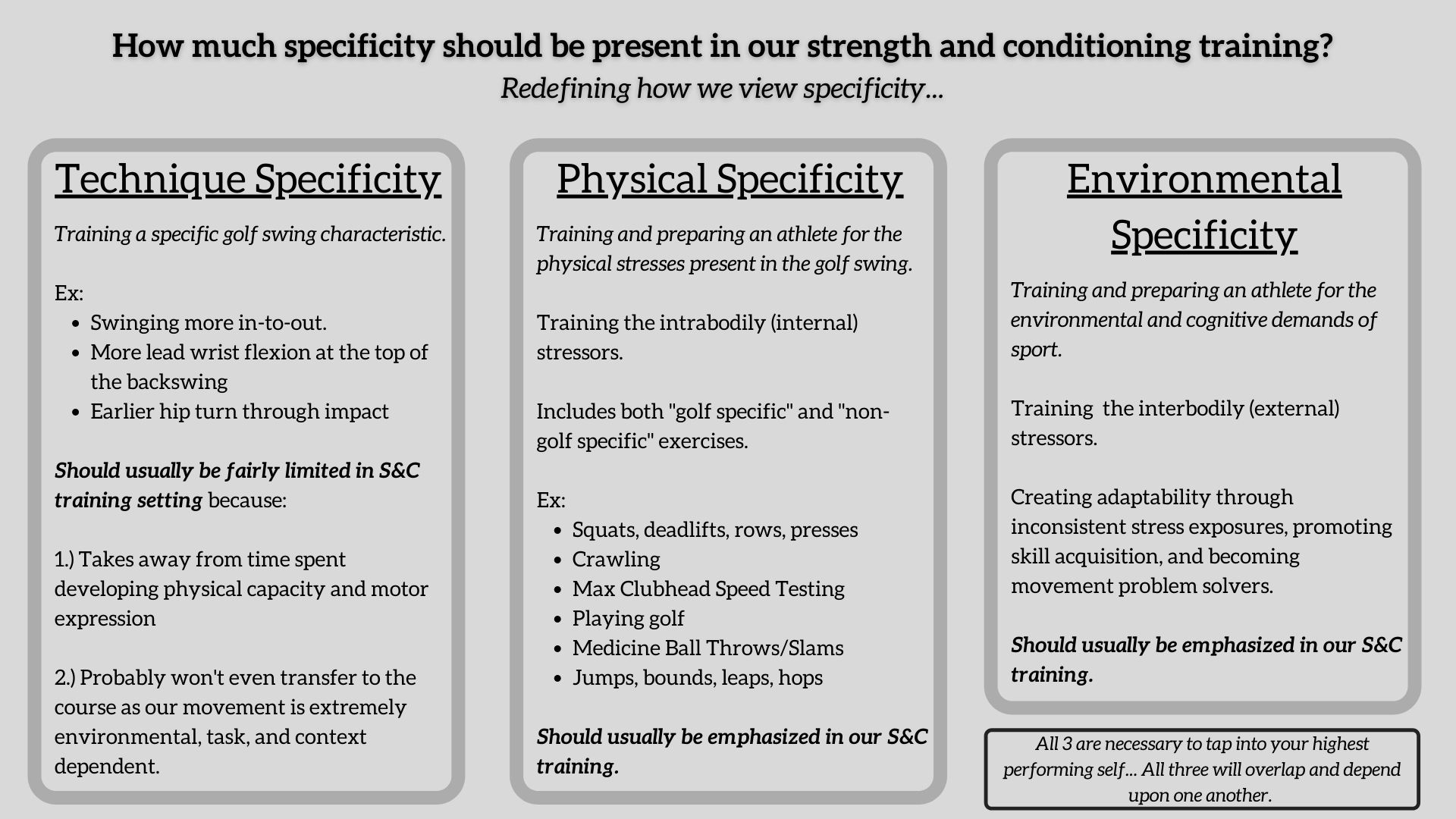An argument that rolls through the golf training community is, at what point should we include “golf specific” movements in our training.
.
.
.
On one side you have who we will call, the specifists, who maximize the degree of sport specificity inserted into an athlete’s sports performance training (for purposes of this article, sports performance is synonymous with strength and conditioning).
On the other side, we have the generalists, who seek to eliminate (or limit) the amount of sport specificity we maintain in our training.
.
.
.
The “correct” answer, like most things in this world, is somewhere in between the two.
Let’s define some things…
The toughest part of this argument is defining what truly constitutes a “sport specific” movement, and what doesn’t.
And further, where is the cutoff line between sports performance training and actually playing the sport, because I would argue that actually playing the sport is a massive part of our sports performance training.
So here are three important definitions that we should define upfront and will expand on later…
Technique Specificity ~ Training the actual golf swing. Trying to improve technique by focusing on a certain swing characteristic. Ex: Trying to eliminate the over-the-top swing plane, or changing the level of flexion your leading wrist experiences in the backswing.
Physical Specificity ~ Training the internal, physical stresses present in your golf swing. We can do so by looking at which muscles and bodily segments absorb and produce force, watching your swing and understanding where potential movement flaws are being created.
Mental/Cognitive/Environmental Specificity ~ Training our mind and cognitive abilities to be adaptable and resilient within the sporting context (looking at the relationship between our internal body and external environment). Meaning, training in a manner that elicits higher levels of mental adaptability and strength, as well as preparing our perceptual-action coupling system to apply physical outputs to the actual sport.
In general, a swing coach will be looking at the first of these (and a little of the third), while a sports performance coach will primarily be looking at the last two, however, there is a blurry grey area between these three ideas as, at some point, they all need to come together in order to produce your greatest golf success.
So, what is the goal of Sports Performance?
In my opinion, the goal of sports performance training is to improve our athletic abilities and holistic being in order to become more resilient, robust and adaptable. In terms of the golfer, this means our goals are to boost performance and injury resilience on the course.
Doing so requires us to train in a manner that produces and transfers greater movement abilities directly into our lives, and indirectly into our golf games.
The goal isn’t to look like a bodybuilder.
Or move weight like a powerlifter.
The goal is to become a better mover, a better problem solver with our movement, and, in the end, a better golfer.
This short discussion is important as it provides the context and background to the question of: How specific should our training be?
The Summary:
Technique Specificity
In general, 95% of our training should avoid technique specificity, meaning, we should very rarely seek to actually improve technique and apply a specific swing characteristic in the training setting (weight room).
Doing so will, more than likely, take away from the physical adaptations we are trying to create in training.
For example, let’s say you are a slicer. You maintain a very over-the-top swing plane and struggle rotating through the ball. You’ve been told you have an “armsy” swing.
This is something we can’t fix in the weight room alone. And further, trying to take the time to fix it in the weight room does two things:
- It takes away from the time spent on other physical training
- It is doubtful that any technique changes made in the training setting (weight room) will transfer
Sporting movement is extremely environmentally and task dependent, meaning, “fixing” your over-the-top swing during a weight room training session does not guarantee it will be fixed when you step on the course, in fact, it more than likely won’t be.
Now, I say 95% because everything is context dependent and I have absolutely made use of technique specific training in my athlete’s training. There is a time and place for everything.
For example, we can use the information present in your swing to shape our training. For our slicer and armsy swinger we continue to refer to, we should make sure to complete kneeling wood chops from more of an acute angle of pull, in order to place your arms in a more “shallowed” and in-to-out swing plane position.
Very importantly, understand that “technique” is very different than “golf specific” training. Technique means we are trying to intently apply a specific swing characteristic into our training in the hopes of it transferring to the range. Golf specific training is much more vague, and to me, means trying to move in a manner more synonymous with your golf swing, while not necessarily training the technique aspect of your swing. This will show itself in training in the form of medicine ball throws, sledge hammer slams, rotational rows and punches, etc.
So, to summarize…
Limit the amount of true technique work you do within your sports performance and strength and conditioning training. In general, save the technique work for the range session. By doing so you will:
- Truly reap the rewards of your newfound physical output base
- Make actual swing changes that will transfer to your game
Physical Specificity
You almost can’t have enough of this. In my opinion, this is where the majority of your sports performance training should exist.
This is where we create robust and adaptable bodies capable of withstanding high levels of golf specific stresses as well as producing huge amounts of force and velocity. Within this bucket of specificity, we are looking at the intrabodily stresses being created during your swing, and training to maximize our preparation for them.
It is within this category that we increase our physical abilities and our underlying health and movement abilities.
Anything that attempts to build our physical capacity, falls under this umbrella.
Squats. Deadlifts. Lunges. Jumps. Plyometrics. Skipping. Crawling. Max out clubhead speed testing. Push ups. Rows. Medicine ball throws. The list goes on, and on, and on.
I would even consider a range session or going and playing 18 a form of physical specificity!
Both “golf specific” and “non-golf specific” physical training falls under this umbrella as they should both be utilized to prepare and maximize our golf swings.
* Remember, “golf specific” is different than “technique specificity” *
The majority of our training should fall under this category as it is fairly all encompassing… I would estimate between 80 and 90%.
Environmental Specificity
I won’t get too deep into this topic because it could go on for pages and pages.
But the central premise is that the game of golf takes place in a dynamic environment that continually challenges us to be adaptable from both a physical as well as a cognitive standpoint.
A large amount of success on the course is dependent on our ability to adapt and perceive the environment we find ourselves in.
If we think of ‘physical specificity’ as training the intrabodily (internal) stressors, ‘environmental specificity’ looks at the interbodily (external) stressors being created by our relationship with the environement.
We can train these external stressors within our sports performance training by increasing the variability of stresses and environments we expose ourselves to.
An easy example is through movement variability. By increasing our breadth of movement abilities, we are better equipped to overcome any dynamic environment we find ourselves within.
Let’s wrap this thing up…
When it comes to how much specificity, the answer is much, much deeper than it appears on the surface. We need to break down specificity into its separate components.
We also need to understand that amongst the specificity is unbelievably complex variability. By this I mean that a crucial part of training for golf specificity, is training for the variability the sport creates.
To summarize the three buckets of specificity…
When looking at technique specificity, we probably should limit the amount of time we spend in our training focused solely on this.
Physical specificity as well as environmental specificity are things we should attempt to maximize in training. Not only should we strive to create a wider and deeper breadth of physical outputs, but we need to teach our body’s how to apply those outputs in the context of rotational power (more golf specific).
It’s not enough to say YES TO SPECIFICITY, or NO TO SPECIFICITY.
The question is much deeper than that. The goal at the end of the day is to build an adaptable, robust and resilient body, capable of succeeding on the golf course.
And, as always, let’s go low.
About Carter Schmitz

I graduated from the University of St. Thomas in 2019 with a business degree and a minor in exercise science. While there, I played football (as long as we consider being a kicker, playing football) and found two of the deepest passions in life - learning and human performance. Since then, I have become a certified strength coach, TPI Specialist and have had the opportunity to train hundreds of athletes ranging from the middle school to the professional level.
I believe in building humans first, athletes second.
I believe that everybody has extraordinarily high amounts of value to offer.
I believe that the pursuit of improvement will lead to growth, no matter the outcomes.
With my writing, I strive to break down and apply complex ideas in order to boost understanding, draw comparisons from seemingly separated and opposing topics, and empower growth in my readers. Knowledge and understanding are power, and they create the foundation of improvement. Moving forward, I plan on continuing to seek the betterment of my athletes, myself and my community, empowering growth along the way.
Be sure to check out my Instagram and YouTube channel for more content:
Instagram - https://www.instagram.com/coach_carter_schmitz/
YouTube - https://www.youtube.com/channel/UCQ7DxYHKGuZIykzVIaxp3XQ

